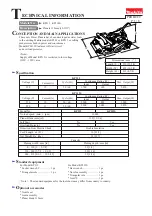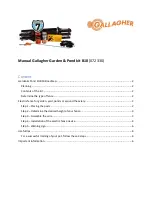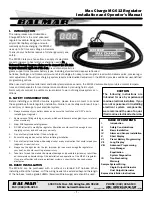
4
5
trapper AB15
3. Commissioning
Switch on energizer with the push button
1
. After 1 second, you will hear a
rhythmic even ticking of the pulses; the energizer is in operation.
The energizer transmits pulses to the fence and the LED display lights up.
The fact of the status LEDs not lighting up points to a defect in the power
supply.
Checking the earthing:
Provoke a short-circuit by driving a metal rod into the ground against the
pasture fence wire (not plastic) about 50 m away from the pasture fencer.
The pasture fencer should now result in the lighting up of only a maximum 1
LED (moist ground) or of a maximum 2 LEDs (dry ground) (Fig. 5 LED 9 and
8). If this is not the case, then raise the number and / or length of the earth
-
ing posts.
Optimal Solar Alignment and Setting
The correct placement of the pasture fencer and the solar panel is crucial for
the best possible operation of the energizer.
1. Position the pasture fencer so that the panel points south.
This positioning enables the panel to absorb a maximum amount of sunlight
even during the few light winter days When placing the energizer, consider
the position of the sun throughout the day and avoid a location which could
cover the energizer with shade from trees, bushes or high grass.
2. Determine the correct angle of inclination for the solar panel.
The position of the sun above the horizon changes during the seasons. As
a general recommendation, an angle of 50 degrees is optimal for long-term
use in most parts of Europe. Nevertheless, the angle can be adjusted condi
-
tional upon the season to optimize the output of the solar panel for recharg
-
ing the rechargeable battery (see Fig. below). The steeper the angle of
inclination, the greater the cleaning effect during rain or snow.
Recommended setting angle of the panel
South Europe / North Africa (South CH & A)
Winter
Nov. - Feb.
Spring
Mar. & Apr.
Summer
May & Aug.
Fall
Sept. & Oct.
50°
43°
36°
Empfohlener Anstellwinkel des Panels
Nord- & Mitteleuropa (einschließlich A & CH)
Winter
Nov. - Feb.
Frühjahr
Mär. & Apr.
Sommer
Mai & Aug.
Herbst
Sep. & Okt.
60°
50°
43°
It may be the case that in winter (except for southern Europe) there are not
enough hours of sunshine to fully charge the rechargeable battery.
3. Regularly remove any deposits and dirt from the solar panel
This includes removing cut grass, dust (specifically along gravel paths),
leaves and snow, since these can reduce the performance of the module for
recharging the rechargeable battery.
Only check the rechargeable battery indicator in solar operation at dawn
(without sunlight).
WARNING:
Do not leave the switched off pasture fencer in the sun with a re
-
chargeable battery and a solar panel for a longer period. Why?
This could damage the rechargeable battery.
4. Energizer Operating Description
Solar operation:
The solar panel produces electricity as soon as it is exposed to usable sunlight. The pasture fencer constantly requires elec
-
tricity - by day as well as by night. The electricity generated in this way by the panel is stored in a rechargeable 12V battery,
which means the energizer can operate without sunlight or can be supplied directly by a.
9V battery. The solar panel may not always have a sufficiently large output
to fully recharge a rechargeable battery – especially in dark, grey and misty months (e.g. October to
February).
For temperatures around 0 degrees centigrade or below, we recommend the use of a large 9 V alkaline battery instead
of a 12 V rechargeable battery.
The energizer is operated primarily from the solar panel. If the solar panel does not have sufficient output,
the energizer switches automatically to the connected 9 volt battery or to the 12 volt rechargeable battery.
Rechargeable battery indicator:
The rechargeable battery indicator provides information about the rechargeable battery or battery voltage. The solar display
lights up constantly in green when the solar panel charging voltage is greater than the voltage of the rechargeable battery/
battery. Whilst the solar panel charges the 12V rechargeable battery, it does not charge the 9 volt battery.
5. Maintenance
Table 12 (9V battery)
Remaining capacity
Flashing
light
green
15-100%
Battery good
Flashing
light
red/green
5-15
%
Replace battery
Flashing
light
red
5
%
Battery fully depleted
9V battery -
immediately
replace
Replace the battery at the latest when 95% discharged (only 5% charge capacity left).
The battery indicator (LED2) lights up:




































